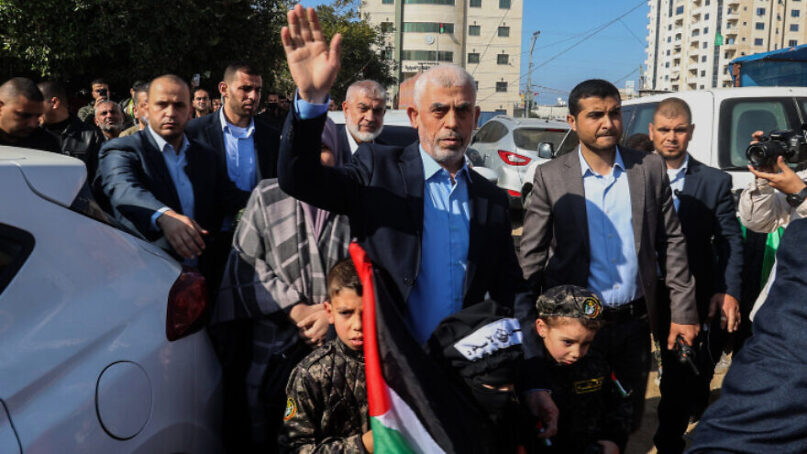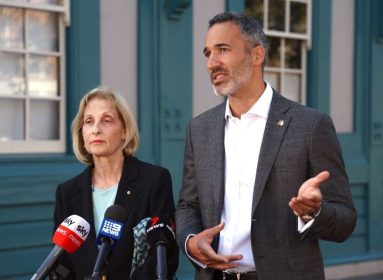
By Yaakov Lappin
(JNS) Thirty-five years after its formation, the Hamas terror organization rules the Gaza Strip without challenge, juggles its roles of a regime and a terror army, and looks to create multiple fronts of attack against Israel in a future war, Israeli observers tell JNS.
On Dec. 14, tens of thousands of Hamas supporters and operatives gathered at Gaza City’s Katiba Gardens to mark the movement’s 35th anniversary.
Yahya al-Sinwar, the Islamist group’s leader in Gaza, reiterated the organization’s well-known slogans but emphasized their urgency due to the imminent swearing-in of a right-wing Israeli government.
Palestinians are in “open confrontation” with Israel, he said, the Al-Aqsa mosque on Jerusalem’s Temple Mount is in danger from the “Talmudic, fascist, Zionist, rightist government,” he claimed, and Hamas would respond forcefully to any threat, he warned.
“We will come to you with an endless number of rockets; we will come to you with an endless number of soldiers,” said al-Sinwar, while adding that Israel’s soon-to-be government was seeking a “religious war.”
Between 2014, when Hamas and Israel fought a two-month conflict (“Operation Defensive Edge”), and May 2021, when they clashed again during “Operation Guardian of the Walls,” Hamas is believed to have amassed some 15,000 rockets.
Of the 4,300 rockets fired at Israel during the 11-day conflict in 2021, most were Hamas’s, and since then, Hamas has been busy replenishing its arsenal using Iranian know-how. Many of its rocket production sites were funded by foreign sources including Iran, which provides Hamas and Palestinian Islamic Jihad, the second-largest terror faction in Gaza, with a combined annual budget of $150 million.
Faced with a terrorist faction that does not recognize its right to exist, Israel has, since Hamas’s violent coup in Gaza in 2007, in which Hamas toppled its bitter rival from power, the Fatah-run Palestinian Authority, relied on force to deal with the Islamist group.
Lt. Gen. Aviv Kochavi, the outgoing Israel Defense Forces chief of Staff, noted in a speech this month that “these have been two of the quietest and most stable years that southern Israel and Gaza have experienced. That is a result of a strategy [by Israel] whose central plank is the use of force.”
Israeli military operations have produced a reality in which “Hamas is not only not responding to our attacks, it’s not even thinking of responding,” he said. “This is mainly because of the activation of force.”
Prof. Kobi Michael, a senior researcher at the Tel Aviv-based Institute for National Security Studies and editor-in-chief of INSS’s Strategic Assessment: A Multidisciplinary Journal on National Security, told JNS that while Hamas is more disciplined and more meticulously hierarchical than Fatah, it is not a monolithic entity.
Michael, also a professor at the International Centre for Policing and Security at the University of South Wales in the U.K. and former deputy director-general and head of the Palestinian desk at the Israeli Ministry for Strategic Affairs, said that al-Sinwar controls the most important, strategic asset that Hamas has, the Gaza Strip, where he has been able to consolidate the movement’s civilian regime and military wing.
“It’s not that al-Sinwar is uninterested in the West Bank. He certainly is looking at it, at east Jerusalem, at Arab Israelis, but his first focus is on Gaza,” said Michael.
Ismail Haniyeh, the head of Hamas’s overseas political bureau, in contrast, has a broader view of the group’s role as part of the global Muslim Brotherhood movement.
Haniyeh’s deputy, Saleh al-Arouri, operates out of Istanbul, Damascus and Beirut. He “is focused first and foremost on the West Bank, and, under an orchestrated Iranian and Hezbollah effort, works to build up Hamas militarily and politically there as well as to boost its influence over Arab Israelis,” said Michael.
Working towards a third intifada
“Al-Arouri works closely with Hezbollah and Iran, and coordinates with PIJ [Palestinian Islamic Jihad]. His logic is that an increase in the level of friction between Palestinians and the IDF would cause far higher Palestinian casualties, which in turn would recruit the Palestinian street to a kind of third intifada, which would undermine the P.A.,” Michael assessed.
Prof. Boaz Ganor, founder and executive director of the International Institute for Counter-Terrorism in Herzliya, shared this assessment.
“At surface level, the organization is pleased by its control of the Gaza Strip, after it repressed all possible resistance by the Fatah movement or by other radical elements like Palestinian Islamic Jihad, Salafist elements, and others. The set payments that Qatar sends to Gazan civilians, after Hamas and Israel agreed to this arrangement, strengthen the stability and the regime of the organization in Gaza,” he told JNS.
“In general, the organization has strived in the past and strives today to take over the entire Palestinian arena, including Judea and Samaria, the Palestinian Authority and the PLO. From this perspective, Hamas has not had it easy, and it believes that after P.A. chief Mahmoud Abbas leaves the scene (whether naturally or through other means), and after he did not prepare a successor, and since his departure will likely spark severe rivalries between those who see themselves as potential successors in the Fatah movement, that is when Hamas as an established, strong and organized entity can take over Judea and Samaria as it did Gaza, even if this involves a great deal of bloodshed,” said Ganor.
According to Michael, Hamas and Fatah are competing in a zero-sum game, all but ruling out a real reconciliation between them.
“Hamas in Gaza and al-Arouri all see themselves as the replacement of Fatah,” he said.
According to Ganor, Hamas is a hybrid terror organization, since it controls territory and a population in the Gaza Strip. As such, “it embeds its military systems in the civilian population and uses it as a shield while at the same time the organization sets up political and government systems for the daily management of life in the territory it controls.”
Often, a contradiction exists between the organization’s terrorist essence, which continues to carry out terror activities against Israeli civilian targets, whether through rocket fire at the Israeli home front or by orchestrating attacks in Judea and Samaria, as well as incitement of individuals to go out and conduct such attacks, and the need of the organization to provide the population in Gaza with essential services – food, water, electricity and fuel, Ganor said.
According to Michael, Hamas’s strategy, in which Gaza is the most significant component, has a kind of international intention, but only seemingly.
A 5-front plan of attack
“Hamas is in fact creating multiple fronts against Israel, five fronts designed to deliver a punch of terrorism against Israel from Gaza, east Jerusalem, southern Lebanon, the West Bank and from Arab Israelis,” said Michael.
“Operation Guardian of the Walls [in 2021] was the opening shot of Hamas’s attempt to link all of these things. It began in east Jerusalem, continued with an ultimatum from Gaza, developed into rocket attacks from Gaza, and ended up with fire on Israel’s streets and rockets from southern Lebanon,” he said.
“Alongside this focused effort of building capabilities on five fronts, Hamas in Gaza pursues a logic of separation. This means keeping Gaza quiet while building capabilities in all arenas, and activating the non-Gazan arenas. The reason for this is that Gaza is currently in a type of positive vector of rebuilding, economic growth, Israeli work permits, imports and exports. Egypt is leading significant construction programs, fueled by $500 million of Emirati funding,” said Michael.
Hamas uses this economic cover to achieve quiet, and in turn, uses the quiet to build up its force and prepare for the day of conflict, he cautioned.
“The general idea is to win control of the hearts and minds of the Palestinian public, and to activate all fronts on the day that the order arrives,” said Michael.
Ganor noted that the Hamas leadership is traditionally split between the political and military wings, and between the leadership in Gaza and the one overseas.
“The military leadership leaves the political leadership in Gaza to manage the affairs of the regime set up in Gaza, and in fact does not intervene in the various civilian affairs, but it reserves for itself the autonomy to manage military affairs—arming itself, recruiting operatives to the military wing, and of course the military and terrorist activities against Israel,” he said.
“This wing also acts on occasion to rein in other factions in Gaza, like PIJ. Within Hamas, the overseas leadership has seen a decrease in importance over the years, but it remains the body that represents the interests of the organization vis-à-vis Arab states and the states that provide support for Hamas, foremost among them Qatar, Turkey and Iran. The overseas leadership also maintains ties with Hezbollah in Lebanon,” said Ganor.
Ultimately, Michael said, Hamas believes it will be able to destroy Israel and replace it with a Palestinian Islamic state.
“Hamas knows how to exhibit operative and even strategic pragmaticism, but that’s not the same as moderation. Its final goal is clearly stated in the Hamas Charter,” he said. Unlike the West’s conception of time, which is based on rational cost-benefit future analysis, Hamas views the past, presence and future all together, and wishes to return to a past period of Islamic glory, he continued.
“Hamas in its vision liberates ‘Palestine’ from the [Mediterranean] Sea to the [Jordan] River, and this becomes part of a bigger puzzle, the Islamic nation, from Marrakesh to Bangladesh,” said Michael.
Israeli deterrence and the economic angle
In the more immediate time frame, said Ganor, Israeli policy towards Hamas reflects the assessment by governments over the years that their paramount goal is to preserve, as much as possible, the quiet on the southern border, to reinforce the border with the Strip with advanced technology, a smart fence and military units that can protect civilian communities and allow farmers to work their land in the area without endangering lives.
“This goal is achieved through defensive military means but, over recent years, also through a policy of zero tolerance for hostile military or terrorist activities from Gaza—rocket and mortar fire, explosive balloons, infiltration attempts into Israeli territory through attack tunnels or the sea, and more,” said Ganor.
“Israel has designated Hamas as being responsible for all that occurs in Gaza and every attempted attack on Israel, even if conducted by a ‘rebellious’ organization, triggers a response against Hamas so that it reins in other organizations,” he said.
Exceptions to this policy include the Israeli operations against PIJ only—“Operation Black Belt” in November 2019 and “Operation Breaking Dawn” in August 202—during both of which Hamas sat on the sidelines and allowed the weaker PIJ to absorb blows from the IDF without intervening.
“In order to preserve the quiet, Israel agreed to the transfer of funds and salaries from Qatar to Gazan residents. Under the Bennett-Lapid government, Israel increased the number of work permits for Gazans into Israel. It appears as if the combination of an improvement in the economic situation in Gaza together with a policy of zero tolerance for any hostile act from Gaza towards Israel obtained the goal and led to relative quiet since ‘Operation Guardian of the Walls’ in May 2021,” said Ganor.
However, he warned, “the current quiet could however be deceptive. Hamas has not ceased its armament efforts and is growing its rocket arsenal while trying to enlarge the rockets’ range. Hamas has increased its attempts to incite Palestinians in Judea and Samaria to attack within Israel, and also encourages them to rebel against the P.A. If no military eruption occurs beforehand, it seems that the boiling point will occur with the start of the battle to succeed Abbas.”
PHOTO: Yahya al-Sinwar, leader of Hamas in the Gaza Strip, at a rally in Gaza City marking the 35th anniversary of the Islamist movement, Dec. 14, 2022. Photo by Atia Mohammed/Flash90.







 Southern New England Jewish Ledger
Southern New England Jewish Ledger














